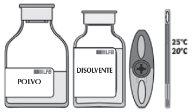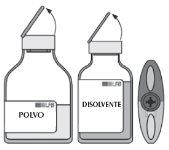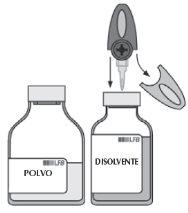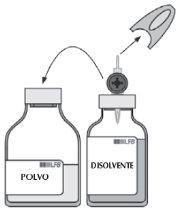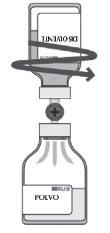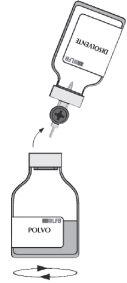
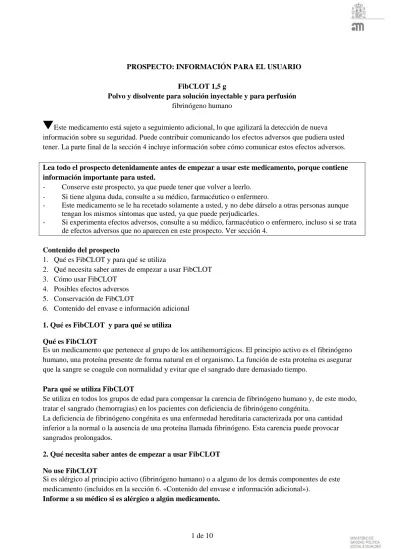
ФИБКЛОТ 1,5 г ПОРОШОК И РАСТВОРИТЕЛЬ ДЛЯ ПРИГОТОВЛЕНИЯ РАСТВОРА ДЛЯ ИНЪЕКЦИЙ И ДЛЯ ИНФУЗИЙ

Спросите врача о рецепте на ФИБКЛОТ 1,5 г ПОРОШОК И РАСТВОРИТЕЛЬ ДЛЯ ПРИГОТОВЛЕНИЯ РАСТВОРА ДЛЯ ИНЪЕКЦИЙ И ДЛЯ ИНФУЗИЙ

Инструкция по применению ФИБКЛОТ 1,5 г ПОРОШОК И РАСТВОРИТЕЛЬ ДЛЯ ПРИГОТОВЛЕНИЯ РАСТВОРА ДЛЯ ИНЪЕКЦИЙ И ДЛЯ ИНФУЗИЙ
Введение
ПРОСПЕКТ: ИНФОРМАЦИЯ ДЛЯ ПОЛЬЗОВАТЕЛЯ
FibCLOT 1,5г
Порошок и растворитель для инъекционного и перфузионного раствора
человеческий фибриноген
Прочитайте внимательно весь листок перед началом использования этого лекарства, поскольку он содержит важную информацию для вас.
- Сохраните этот листок, поскольку вам может понадобиться прочитать его снова.
- Если у вас есть какие-либо вопросы, проконсультируйтесь с вашим врачом, фармацевтом или медсестрой.
- Это лекарство было назначено только вам, и не передавайте его другим людям, даже если у них такие же симптомы, как у вас, поскольку оно может нанести им вред.
- Если вы испытываете побочные эффекты, проконсультируйтесь с вашим врачом, фармацевтом или медсестрой, даже если это побочные эффекты, которые не указаны в этом листке. См. раздел 4.
Содержание листка
- Что такое FibCLOT и для чего он используется
- Что вам нужно знать перед началом использования FibCLOT
- Как использовать FibCLOT
- Возможные побочные эффекты
- Хранение FibCLOT
- Содержание упаковки и дополнительная информация
1. Что такое FibCLOT и для чего он используется
Что такое FibCLOT
Это лекарство относится к группе антигеморрагических средств. Активное вещество - человеческий фибриноген, белок, присутствующий в организме в натуральной форме. Функция этого белка заключается в обеспечении нормального свертывания крови и предотвращении слишком длительного кровотечения.
Для чего используется FibCLOT
Он используется во всех возрастных группах для компенсации недостатка человеческого фибриногена и, таким образом, лечения кровотечений (геморрагий) у пациентов с врожденным дефицитом фибриногена.
Врожденный дефицит фибриногена - это наследственное заболевание, характеризующееся снижением или отсутствием белка фибриногена. Этот дефицит может привести к длительным кровотечениям.
2. Что вам нужно знать перед началом использования FibCLOT
Не используйте FibCLOT
Если вы аллергичны к активному веществу (человеческому фибриногену) или к любому другому компоненту этого лекарства (указанному в разделе 6 «Содержание упаковки и дополнительная информация»).
Сообщите вашему врачу, если вы аллергичны к любому лекарству.
Предостережения и меры предосторожности:
Проконсультируйтесь с вашим врачом, фармацевтом или медсестрой перед началом использования FibCLOT.
Отслеживаемость
С целью улучшения отслеживаемости биологических лекарств, имя и номер партии лекарства, которое вводится, должны быть четко зарегистрированы.
Риск тромбов
При высоких дозах или повторных введениях это лекарство может увеличить риск тромбов в кровеносных сосудах.
Следовательно, ваш врач должен взвесить преимущества этого лекарства и риск тромбов, особенно:
- Если у вас был инфаркт миокарда (анамнез коронарной болезни или инфаркта миокарда).
- Если у вас есть печеночная болезнь.
- Если вы недавно прошли операцию.
- Если вы скоро пройдете операцию.
- У новорожденных (неонатов).
- Если у вас повышенный риск тромбов.
Ваш врач может назначить дополнительные анализы для наблюдения за этим риском.
Риск аллергии
Ваш врач проинформирует вас о признаках предупреждения аллергической реакции или тяжелой аллергической реакции (анafilактической реакции) (см. раздел 4 «Возможные побочные эффекты»). Если появится любой из этих эффектов, следует немедленно прекратить введение этого лекарства.
Вирусная безопасность
Это лекарство производится из человеческой плазмы (жидкой части крови).
При производстве лекарств из крови или плазмы человека принимаются определенные меры для предотвращения заражения пациентов. Некоторые из этих мер включают:
- осторожный отбор доноров крови и плазмы для обеспечения исключения тех, кто имеет риск быть носителями инфекций,
- проверку каждой донорской крови и плазмы на наличие признаков вирусных инфекций,
- включение стадий обработки крови или плазмы, которые могут инактивировать или удалить вирусы.
Несмотря на эти меры, при введении лекарств, полученных из человеческой крови или плазмы, нельзя полностью исключить риск заражения инфекцией. Это также относится к неизвестным или возникающим вирусам и другим типам инфекций.
Принятые меры считаются эффективными для вирусов с оболочкой, таких как вирус иммунодефицита человека (ВИЧ или вирус СПИДа), вирус гепатита Б и вирус гепатита С, а также для необолоченного вируса гепатита А.
Принятые меры могут иметь ограниченную ценность против необолоченных вирусов, таких как парвовирус В19. Инфекция парвовирусом В19 может быть тяжелой у беременных женщин (инфекция плода) и у людей с ослабленной иммунной системой или с некоторыми типами анемии (например, болезнь клеток фalciform или гемолитическая анемия).
Если вы периодически/повторно получаете продукты, полученные из человеческой плазмы, ваш врач может порекомендовать вам рассмотреть возможность вакцинации против гепатита А и В.
Иммунный риск
В случае заместительной терапии с помощью факторов свертывания крови в контексте других врожденных дефицитов были отмечены иммунные реакции, но нет данных о фибриногене.
Дети и подростки
Предостережения и меры предосторожности, указанные выше, действительны для детей и подростков.
Использование FibCLOT с другими лекарствами
Сообщите вашему врачу или фармацевту, если вы используете, недавно использовали или можете использовать любое другое лекарство, включая те, которые можно купить без рецепта.
Не было отмечено взаимодействия между этим лечением и другими лекарствами на данный момент. Однако не следует смешивать его с другими продуктами и/или лекарствами.
Беременность и лактация
- Если вы беременны или в период лактации, считаете, что можете быть беременной или планируете стать беременной, проконсультируйтесь с вашим врачом перед использованием этого лекарства. Это лекарство должно использоваться во время беременности и лактации только по рекомендации врача.
- Проконсультируйтесь с вашим врачом, если вы обнаружите, что вы беременны во время лечения, поскольку только он может определить, нужно ли продолжать лечение.
Вождение и использование машин
Влияние этого лекарства на способность управлять транспортными средствами и работать с машинами отсутствует.
FibCLOT содержит натрий.
Это лекарство содержит до 3 ммоль (или 69 мг) натрия (основного компонента кухонной соли или столовой соли) на флакон. Это количество эквивалентно 3,45% от максимальной суточной нормы потребления натрия для взрослого.
Если вы придерживаетесь диеты с низким содержанием соли, вам следует учитывать это.
3. Как использовать FibCLOT
Лечение должно начинаться под наблюдением врача с опытом лечения врожденного дефицита фибриногена.
Доза
Ваш врач определит подходящую дозу и частоту, которые будут зависеть от следующих факторов:
- ваш вес,
- тяжесть вашего расстройства,
- местоположение и объем кровотечения или характер вашей операции,
- ваше общее состояние здоровья.
Ваш врач порекомендует вам пройти анализ крови во время лечения для проверки количества фибриногена в организме.
В зависимости от результатов анализа ваш врач может решить скорректировать дозу и частоту введения.
Частота введения
Ваш врач определит, с какой частотой должны вводиться инъекции.
Кроме того, он скорректирует количество инъекций в зависимости от интенсивности кровотечения и эффективности лечения.
В разделе, предназначенном для медицинских специалистов в конце этого листка, содержится информация о частоте и продолжительности лечения в различных ситуациях.
Способ введения:
Это лекарство должно вводиться в вену. Обязательно использовать оборудование для перфузии с фильтром 15 мкм, такое как то, которое поставляется с упаковкой.
Если у вас есть какие-либо другие вопросы о использовании этого лекарства, проконсультируйтесь с вашим врачом, фармацевтом или медсестрой.
Если вы используете больше FibCLOT, чем следует
Для предотвращения риска передозировки ваш врач будет проводить периодические анализы крови для проверки количества фибриногена в организме.
В случае передозировки нельзя исключить риск образования аномальных тромбов в крови.
4. Возможные побочные эффекты
Как и все лекарства, это лекарство может вызывать побочные эффекты, хотя не все люди испытывают их.
Самые тяжелые побочные эффекты:
- Аллергические реакции:как и с любым белковым препаратом, введенным внутривенно, могут возникать аллергические реакции. В некоторых случаях эти реакции ухудшались до тяжелой аллергической реакции, иногда с выраженным снижением артериального давления (анafilактический шок).
Признаки предупреждения аллергических реакций:
- чувство жжения и онемения в месте инъекции,
- онемение,
- покраснение, зуд и сыпь,
- крапивница,
- воспаление кожи,
- бледность,
- отек лица или горла,
- кашель,
- свистящее дыхание (podobное астме),
- давление на грудь,
- учащенное сердцебиение,
- низкое артериальное давление,
- чрезмерная усталость (летаргия),
- тревога,
- озноб,
- чувство болезни (тошнота), рвота,
Если возникает любой из этих эффектов, свяжитесь немедленно сврачом, который прекратит лечение этим лекарством и/илиначнет соответствующее лечение в зависимости от типа и тяжести реакции. |
- Тромбы:могут образовываться тромбы в кровеносных сосудах. Это может привести к:
- инфаркту миокарда, признаками которого являются внезапная боль в груди или затруднение дыхания;
- инсульту, признаками которого являются внезапное появление мышечной слабости, потеря чувствительности и/или равновесия, снижение бдительности или затруднение речи;
- тяжелому состоянию, называемому легочной эмболией (тромб, блокирующий артерию легких), признаками которой являются боль в груди, затруднение дыхания или кашель с кровью;
- тромбу в вене (тромбоз вены), признаками которого являются покраснение, чувство тепла, боль, боль при пальпации или отек в одной или обеих ногах.
Если возникает любой из этих эффектов, свяжитесь немедленно сврачом, который прекратит лечение этим лекарством и/илиначнет соответствующее лечение в зависимости от типа и тяжести реакции. |
Следующие побочные эффекты являются частыми(могут возникать у до 1 из 10 пациентов, получающих перфузию):
- головная боль.
Следующие побочные эффекты являются нечастыми(могут возникать у до 1 из 100 пациентов, получающих перфузию):
- аллергическая реакция (такая как анafilактический шок, бледность, рвота, кашель, низкое артериальное давление, озноб, urticaria; см. также раздел «Аллергические реакции»),
- головокружение,
- рвота (связанная с головной болью)
- звон в ушах,
- нарушения кровообращения (глубокий тромбоз вены, поверхностный флеботромбоз),
- затруднение дыхания (астма),
- сыпь на коже, покраснение кожи, раздражение кожи, ночная потливость,
- чувство тепла.
Дети и подростки
Частота, тип и тяжесть побочных эффектов аналогичны у педиатрических пациентов (от рождения до 17 лет включительно) и взрослых, за исключением реакций аллергического или анafilактического типа, которые возникли чаще у педиатрических пациентов.
Сообщение о побочных эффектах
Если вы испытываете любой побочный эффект, проконсультируйтесь с вашим врачом, фармацевтом или медсестрой, даже если это побочные эффекты, которые не указаны в этом листке. Вы также можете сообщить о них напрямую через систему фармаковигиланса: www.notificaRAM.es. Сообщая о побочных эффектах, вы можете способствовать предоставлению более полной информации о безопасности этого лекарства.
5. Хранение FibCLOT
Храните это лекарство в недоступном для детей месте.
Не используйте это лекарство после даты истечения срока годности, указанной на этикетке и упаковке. Дата истечения срока годности - последний день месяца, указанного.
Не храните при температуре выше 25°C. Не замораживайте.
Храните флакон в наружной упаковке для защиты от света и влаги.
Продукт должен использоваться сразу после восстановления. Не храните восстановленный продукт.
Не используйте это лекарство, если восстановленный раствор мутный или содержит осадок.
Лекарства не должны выбрасываться в канализацию или мусор. Спросите вашего фармацевта, как правильно утилизировать упаковку и лекарства, которые вам больше не нужны. Таким образом, вы поможете защитить окружающую среду.
6. Содержимое упаковки и дополнительная информация
Состав ФибКЛОТ
Активное вещество - человеческий фибриноген (1,5 г на флакон). После восстановления с 100 мл воды для инъекционных препаратов ФибКЛОТ содержит 15 мг/мл человеческого фибриногена.
Другие компоненты - гидрохлорид аргинина, изолейцин, гидрохлорид лизина, глицин, дигидрат цитрата натрия и растворитель (вода для инъекционных препаратов).
Внешний вид продукта и содержимое упаковки
Этот препарат выпускается в виде порошка, сопровождаемого растворителем для раствора для инъекционных препаратов в стеклянных флаконах, комплекте для переноса и комплекте для перфузии с фильтром 15 мкм.
Восстановленный раствор должен быть практически бесцветным, слегка опалесцирующим (должен иметь перламутровый блеск).
Владелец разрешения на маркетинг:
Лаборатор Франсез дю Фраксьоннемен и Биотехнологий
Тур В – 102 Буалдьё 19-й этаж, 92800 Пюто, ФРАНЦИЯ
Тел.: +33(0) 1 69 82 70 10
Факс: +33(0) 1 69 82 19 03
Ответственный за производство:
ЛФБ БИОМЕДИКАМЕНТС
59 rue de Trévise, 59000 Лилль, ФРАНЦИЯ
Вы можете запросить дополнительную информацию о этом препарате, обратившись к местному представителю владельца разрешения на маркетинг:
ЛФБ БИОТЕРАПИИ ИСПАНИЯ
К/ Диего де Леон 47
28006 Мадрид
(ИСПАНИЯ)
Этот препарат разрешен в государствах-членах Европейского экономического пространства под следующими названиями:
Германия, Австрия, Испания, Греция, Великобритания: ФибКЛОТ
Дания, Финляндия, Венгрия, Люксембург, Норвегия, Нидерланды, Швеция: ФибклотБельгия: Фибклот 1,5 г, порошок и растворитель для инъекционного раствора/для перфузии
Италия: Фибриклотте
Дата последнего обзора этой инструкции: 06/2024
---------------------------------------------------------------------------------------------------------------------------
Эта информация предназначена только для медицинских специалистов:
Лечение должно начинаться под наблюдением врача с опытом лечения нарушений свертываемости крови.
Дозировка
Доза и продолжительность заместительной терапии зависят от тяжести нарушения, местоположения и степени кровотечения, а также от клинического состояния пациента.
Необходимо определить концентрацию фибриногена (функционального) для расчета индивидуальной дозы; кроме того, количество и частота введения должны рассчитываться для каждого пациента с помощью периодического определения концентрации фибриногена в плазме и постоянного наблюдения за клиническим состоянием пациента и другими применяемыми заместительными терапиями.
Нормальная концентрация фибриногена в плазме колеблется между 1,5 и 4,5 г/л. При врожденной гипо- или афибриногенемии критическая концентрация фибриногена в плазме, ниже которой могут возникать кровотечения, составляет примерно 0,5-1,0 г/л.
В случае проведения крупной операции крайне важно наблюдать за заместительной терапией с помощью коагулологических тестов.
Лечение кровотечений и профилактика в периоперационном периоде у пациентов с врожденной гипо- или афибриногенемией и известной склонностью к кровотечениям.
Для лечения нехирургических кровотечений рекомендуется увеличить концентрацию фибриногена до 1 г/л и поддерживать эту концентрацию до тех пор, пока гемостаз не будет контролируемым, и выше 0,5 г/л до тех пор, пока заживление не будет завершено.
Для предотвращения чрезмерного кровотечения во время хирургических процедур рекомендуется профилактическое лечение для увеличения концентрации фибриногена до 1 г/л и поддержания этой концентрации до тех пор, пока гемостаз не будет контролируемым, и выше 0,5 г/л до тех пор, пока заживление не будет завершено.
В случае хирургической операции или лечения нехирургического кровотечения доза должна рассчитываться следующим образом:
Доза (г) = [желаемая концентрация (г/л) - базовая концентрация (г/л)] х 1/восстановление (г/л) (г/кг) х вес тела (кг),
«Коэффициент 1/восстановление» определяется восстановлением* пациента (см. раздел 5.2 инструкции), или если восстановление неизвестно:
- 0,053 (г/кг)/(г/л) для детей и подростков <40 кг веса тела< li>
- 0,043 (г/кг)/(г/л) для взрослых и подростков ≥40 кг веса тела.
- Пример расчета восстановления пациента и дозы
Для пациента весом 60 кг с базовой концентрацией фибриногена, не обнаруженной, и увеличением фибриногена до 1,20 г/л через 1 час после перфузии 0,060 г/кг ФибКЛОТ:
- Расчет восстановления пациента:
1,20 (г/л) / 0,060 (г/кг) = 20,0 (г/л)/(г/кг)
- Расчет дозы для увеличения до 1,0 г/л:
1,0 г/л х 1 / 20,0 (г/л)/(г/кг) [или 0,050 (г/кг)/(г/л)] х 60 кг = 3 г
В случае возникновения чрезвычайной ситуации, когда базовая концентрация фибриногена неизвестна, рекомендуемая начальная доза составляет 0,05 г/кг веса тела, введенная внутривенно у взрослых и подростков ≥40 кг веса тела, и 0,06 г/кг веса тела у детей <40 кг веса тела.< p>
Последующая дозировка (доза и частота введения) должна корректироваться в зависимости от клинического состояния и результатов анализов пациента.
Биологический период полувыведения фибриногена составляет от 3 до 4 дней. Следовательно, если нет потребления, обычно не требуется повторное лечение фибриногеном человека. Учитывая накопление, которое происходит при повторном введении в профилактических целях, доза и частота должны определяться в зависимости от терапевтических целей врача для каждого пациента.
Педиатрическое население
Восстановление и период полувыведения у детей и подростков <40 кг веса тела ниже, чем у взрослых и подростков ≥40 (см. раздел 5.2 инструкции). Следовательно, должны использоваться адаптированные восстановления для расчета дозы ФибКЛОТ в соответствующих группах тела, когда индивидуальное восстановление пациента неизвестно. Можно предположить, что вес < 40 покрывает возрастной диапазон от рождения до примерно 12 лет. Дозировка (доза частота введения) должна корректироваться зависимости индивидуальной клинической реакции пациента.< p>
Восстановление:
Следуйте действующим рекомендациям по асептическим процедурам.
| При необходимости нагрейте два флакона (порошок и растворитель) до температуры окружающей среды. |
| Удалите защитную капсулу с флакона растворителя и флакона порошка. Дезинфицируйте поверхность обоих пробок. |
| Удалите прозрачную защитную оболочку с комплекта для переноса и, совершая поворотное движение, полностью вставьте видимый шип в центр пробки флакона растворителя. |
| Удалите вторую серую защитную оболочку с другого конца комплекта для переноса. Поверните флакон растворителя и быстро вставьте свободный конец шипа в центр пробки флакона порошка, чтобы растворитель мог попасть в порошок. Убедитесь, что шип всегда остается погруженным в растворитель, чтобы избежать преждевременного исчезновения вакуума. |
| Во время переноса совершайте горизонтальное поворотное движение, чтобы струя растворителя распределялась по всей поверхности порошка и стенке флакона. Убедитесь, что весь растворитель переносится. Вакуум автоматически удаляется в конце процедуры переноса с помощью стерильного воздуха, проходящего через дыхательное отверстие комплекта для переноса. |
| Удалите пустой флакон (растворитель) с комплектом для переноса. Чтобы избежать образования пены, осторожно встряхивайте в течение нескольких минут с помощью поворотного движения, пока порошок не будет полностью растворен. |
Перед введением восстановленного препарата необходимо визуально осмотреть его, чтобы убедиться, что он не содержит частиц. Восстановленный раствор должен быть практически бесцветным и слегка опалесцирующим. Не используйте мутные или осадочные растворы.
Введение:
ФибКЛОТ должен вводиться только внутривенно, в виде единственной дозы, сразу после восстановления и со скоростью, не превышающей 4 мл/мин.
Обязательно использовать комплект для перфузии с фильтром 15 мкм, как тот, который поставляется с упаковкой.
Утилизация неиспользованного препарата и всех материалов, которые вступали в контакт с ним, должна осуществляться в соответствии с местными правилами.
Этот препарат не должен смешиваться с другими препаратами и должен вводиться с помощью отдельного шприца для инъекции/перфузии.
- Страна регистрации
- Наличие в аптекахПроблемы с поставками
- Активное вещество
- Требуется рецептДа
- Производитель
- Информация носит справочный характер и не является медицинской рекомендацией. Перед приемом любых препаратов проконсультируйтесь с врачом. Oladoctor не несет ответственности за медицинские решения, принятые на основе этого контента.
- Аналоги ФИБКЛОТ 1,5 г ПОРОШОК И РАСТВОРИТЕЛЬ ДЛЯ ПРИГОТОВЛЕНИЯ РАСТВОРА ДЛЯ ИНЪЕКЦИЙ И ДЛЯ ИНФУЗИЙФорма выпуска: ИНЪЕКЦИОННЫЙ РАСТВОР, 1 гАктивное вещество: фибриноген человекаПроизводитель: Octapharma S.A.Требуется рецептФорма выпуска: ИНЪЕКЦИОННЫЙ РАСТВОР, 1 г (20 мг/мл)Активное вещество: фибриноген человекаПроизводитель: Csl Behring GmbhТребуется рецептФорма выпуска: ИНЪЕКЦИОННЫЙ РАСТВОР, 1000 МЕАктивное вещество: фактор свертывания крови VIIIПроизводитель: Takeda Manufacturing Austria AgТребуется рецепт
Аналоги ФИБКЛОТ 1,5 г ПОРОШОК И РАСТВОРИТЕЛЬ ДЛЯ ПРИГОТОВЛЕНИЯ РАСТВОРА ДЛЯ ИНЪЕКЦИЙ И ДЛЯ ИНФУЗИЙ в других странах
Лучшие аналоги с тем же действующим веществом и терапевтическим эффектом.
Аналог ФИБКЛОТ 1,5 г ПОРОШОК И РАСТВОРИТЕЛЬ ДЛЯ ПРИГОТОВЛЕНИЯ РАСТВОРА ДЛЯ ИНЪЕКЦИЙ И ДЛЯ ИНФУЗИЙ в Польща
Аналог ФИБКЛОТ 1,5 г ПОРОШОК И РАСТВОРИТЕЛЬ ДЛЯ ПРИГОТОВЛЕНИЯ РАСТВОРА ДЛЯ ИНЪЕКЦИЙ И ДЛЯ ИНФУЗИЙ в Україна
Врачи онлайн по ФИБКЛОТ 1,5 г ПОРОШОК И РАСТВОРИТЕЛЬ ДЛЯ ПРИГОТОВЛЕНИЯ РАСТВОРА ДЛЯ ИНЪЕКЦИЙ И ДЛЯ ИНФУЗИЙ
Консультация по дозировке, побочным эффектам, взаимодействиям, противопоказаниям и продлению рецепта на ФИБКЛОТ 1,5 г ПОРОШОК И РАСТВОРИТЕЛЬ ДЛЯ ПРИГОТОВЛЕНИЯ РАСТВОРА ДЛЯ ИНЪЕКЦИЙ И ДЛЯ ИНФУЗИЙ – по решению врача и с учетом местных правил.




